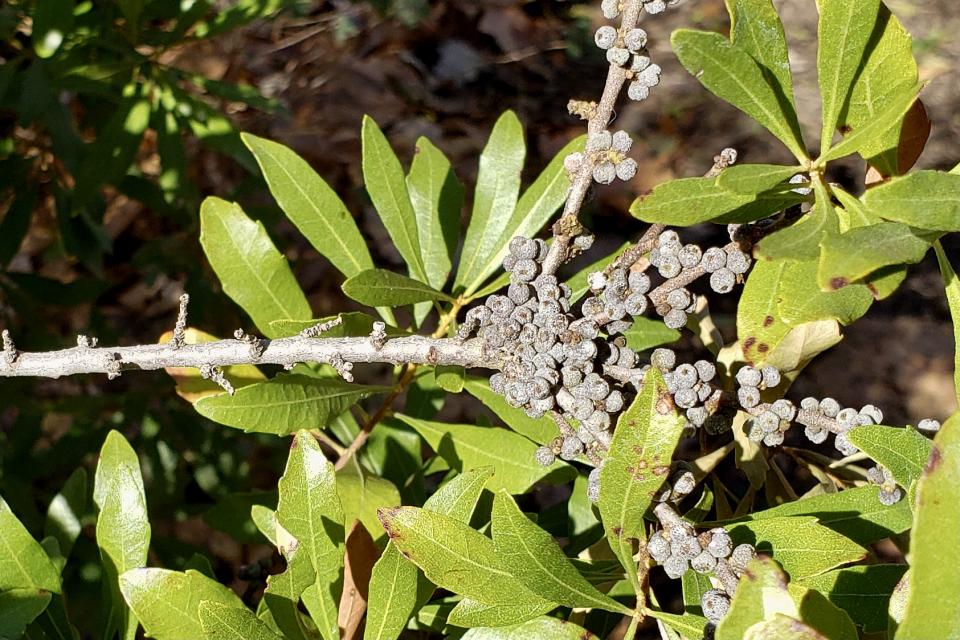The George W. Bush Foundation owns and operates the George W. Bush Presidential Museum. For tickets go to https://www.bushcenter.org/
December Highlights
EVERGREEN SUMAC can grow as a small tree or as a native hedge that takes well to trimming. The female plant produces fuzzy red berries in the fall. Its leaves are green and glossy throughout the winter, then are replaced within a week of dropping in the spring, giving the appearance of being evergreen.
FUN FACT: Evergreen Sumac is a Texas SmartScape plant. It is suited to the region's soil, climate, and precipitation and does not require much—if any—additional irrigation, pesticides, fertilizer, or herbicides to thrive.
A native grass that can be admired this time of year is LITTLE BLUESTEM. It gets its name from the distinct bluish color of the stems in the spring, but it's most striking in the fall and winter when the plant turns reddish-tan with fuzzy white seed heads.
FUN FACT: Little Bluestem’s root system is deep and fibrous, potentially growing 5 feet underground, with some roots developing horizontally. Extensive roots help native grasses withstand periods of drought.

Grown as a shrub or small tree, WAX MYRTLE is a valuable native plant. It is fast growing, its evergreen foliage is aromatic, and the blue-gray waxy berries of the female plants stay on the branches throughout the winter as a source of high energy food for birds.
FUN FACT: Because the aromatic compounds in the foliage were believed to repel insects, wax myrtle was commonly planted around homes to keep pests away. Pioneers made scented candles by simmering the berries in water and collecting the rendered wax.
January Highlights
The medium size MEXICAN WHITE OAK is becoming more popular as a landscape tree and there are several specimens in the park (look off the path around the Native Lawn). This tree has rough bark, oblong leaves 3-5" long (that stay on the tree until spring) and medium-sized acorns. It's drought tolerant and is not as messy as live oaks. It’s known as “Monterrey Oak” by growers.
FUN FACT: Native to Mexico, it was first discovered in Texas in 1992.
The winter months are a great time to view the many components of the HYDROLOGY system here. The goal is to keep all rainwater on site where it can be reused to water the park landscape. There are BIOSWALES (similar to creeks) that slow down and carry storm water to the WET PRAIRIE where it’s filtered into a CISTERN and stored for reuse; a SEEP (a dam that holds the traveling water back, letting it drip slowly into a bioswale to avoid erosion); and a FOREBAY that uses rocks to clean runoff from the building and service area before it flows into a bioswale and on to storage.
CORALBERRY is a low-growing forest shrub that displays dark pink berries all winter long. Birds and small mammals find protection in the tangles of the shrub and substance in the berries. Humans find the pretty color a welcome addition to the dark winter landscape.
FUN FACT: Coralberry plants form extensive colonies and new plants form where a branch’s leaf nodes touch the ground, giving it the impression of walking across the landscape.
February Highlights
MEXICAN BUCKEYE is a welcome sight throughout the year. In spring, it has beautiful pink blossoms; in summer it's covered in leaves with a mix of green (new) and brown (old) seed pods peeking through; and in fall/winter when the leaves drop, the mature brown pods open slightly making room for the seeds to “rattle” inside when the branch is shaken, adding sound to the landscape.
FUN FACT: Another name for a male deer is “buck.” This shrubby tree is so named because of its seed pod’s resemblance to a dark brown “buck’s eye” when partially open.
The NATIVE LAWNS of the center grounds inspire many questions. They are composed of a mix of five different short prairie grasses (Buffalo Grass, Blue Grama, Texas Grama, Poverty Drop Seed and Curly Mesquite). These native lawns require less mowing (3-4 times a year), less watering (1/2 inch every two weeks in drought), and less weeding and feeding than traditional lawns.
FUN FACT: The roots of these grasses go as deep as 5 feet underground, drawing moisture from below during the driest of Texas times.
One of the earliest shrubs to bloom in the park is the native ELBOW BUSH. It's blossoms arrive in February—a time when early pollinators really need nourishment and there’s not much else around. It’s an apt name because its twigs grow at right angles from their branches, creating a unique and easily identifiable feature.
FUN FACT: This shrub is dioecious, meaning the male and female flowers grow on separate plants.